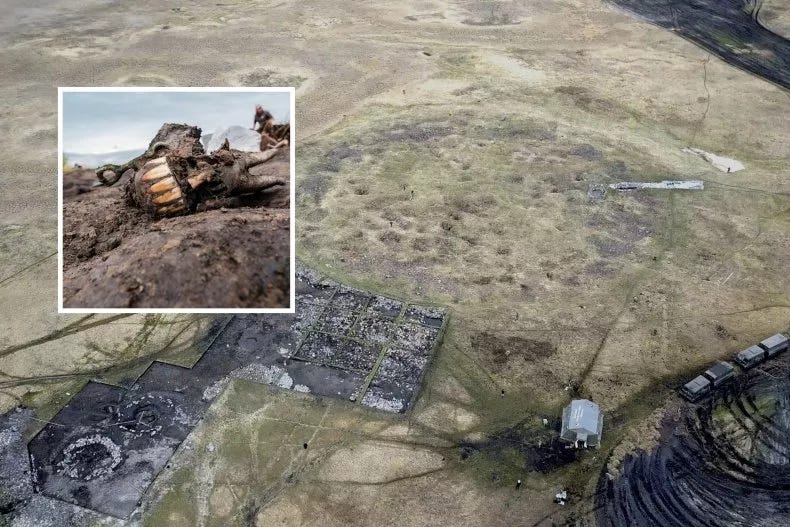The Sacrificial Rites of the Eurasian Steppes
Manage episode 444369746 series 3444207
The Discovery at Tunnug 1
In southern Siberia, archaeologists have uncovered a prehistoric burial mound—Tunnug 1—revealing evidence of human and animal sacrifices from the late 9th century. This remarkable site, situated in Tuva, Russia, offers a rare glimpse into early Iron Age culture on the Eurasian steppes. The findings, detailed in a study published in Antiquity1, showcase the scale of the sacrifices made in honor of an elite figure buried within the mound.
The excavation revealed fragmented remains of at least 18 horses alongside one human. These remains suggest a grand sacrificial ritual, likely conducted to honor and accompany a powerful individual in the afterlife. The site also contained “Scythian-style” artifacts, including horse-riding equipment, linking it to the early horse-centered traditions of the Scythians—a nomadic people renowned for their horsemanship and animal-style art.

The Scythian Connection
The Scythians were a prominent Iron Age people of the Eurasian Steppe, and their distinctive funerary practices were well-documented in ancient texts. Greek historian Herodotus described their customs, though often portraying them as barbaric. Recent archaeological evidence, however, provides insight that goes beyond these ancient descriptions.
Gino Caspari, the senior author of the study from the Max Planck Institute of Geoanthropology and the University of Bern, emphasized the significance of the discovery:
“We discovered a unique burial ritual long thought to be an exaggeration of the Greek historian Herodotus aimed at making the steppe nomads look more barbaric.”
The findings align written records with material evidence spread across the vast Eurasian steppes, bridging historical accounts and archaeological data.
Caspari further elaborates,
“People created a tableau [of] dead humans and of the most valuable domestic animals—it is a display of extreme power.”
Such a display likely served as a warning to outsiders, making it clear that the people of this region were formidable and not to be challenged.
Tracing the Origins of Scythian Rituals
The evidence from Tunnug 1 suggests that the people responsible for these rituals were related to the Scythians, whose influence stretched across the Pontic Steppe in modern-day southwest Russia and Ukraine. Despite their notoriety, the Scythians’ origins have remained somewhat obscure. The recent discoveries point to a possible eastern origin, far from their most well-known settlements in Eastern Europe. Caspari explains:
“Scythian is often understood as an ethnic term. The people at Tunnug were not Scythians in the narrow term of the word. We don’t know what they called themselves. However, their material culture shows a lot of the characteristics that we later find in the northern Black Sea region all the way to the west of the Eurasian steppes.”
While they shared cultural ties, these groups did not identify as a singular people or empire. The findings suggest a culturally related network rather than a unified identity, demonstrating the interconnectedness of early steppe societies.
Connections to the Late Bronze Age and Beyond
The sacrificial practices found at Tunnug 1 share similarities with Late Bronze Age rituals in Mongolia, hinting at the deep and complex origins of Scythian funerary customs. This discovery suggests that the Scythian rituals of sacrifice were influenced by older traditions from even further east and south. Such connections underscore the dynamic exchange of ideas and practices that characterized the early Iron Age on the Eurasian steppes.
Caspari highlights this broad cultural diffusion, noting,
“It is yet another case that highlights the massive changes and the idea transfer happening during the early Iron Age across vast distances on the Eurasian steppes.”
These early exchanges and influences were precursors to the development of later empires, such as those of the Huns and the Mongols, which would shape the course of European and East Asian history.
A Glimpse Into Prehistoric Power Dynamics
The Tunnug 1 discovery provides crucial insight into the power dynamics and cultural practices of the early Iron Age steppes. The elaborate sacrifice of both humans and animals, as well as the strategic placement of their remains, underscores the importance of such rituals in asserting authority and power. For those who encountered these burial mounds, the arrangement of bodies and valuable animals served as a stark message of dominance.
The findings also contribute to a growing understanding of the complex societies that inhabited the steppes long before the rise of the great empires. The evidence suggests a culture deeply rooted in traditions and rituals that extended beyond regional borders, influencing societies thousands of kilometers apart.
Continuing the Exploration of Steppe History
The site of Tunnug 1 and its discoveries represent a critical chapter in the story of the Eurasian steppes. As archaeologists continue to explore and study these ancient landscapes, more pieces of the puzzle will emerge, revealing the intricacies of early steppe cultures and their far-reaching impact on human history.
This ongoing research serves as a reminder of the interconnectedness of ancient societies and the rich tapestry of cultural exchange that has shaped human civilization across millennia.
Sadykov, T., Blochin, J., Taylor, W., Fomicheva, D., Kasparov, A., Khavrin, S., Malyutina, A., Szidat, S., & Caspari, G. (2024). A spectral cavalcade: Early Iron Age horse sacrifice at a royal tomb in southern Siberia. Antiquity, 1–20. https://doi.org/10.15184/aqy.2024.145
7 episodes




